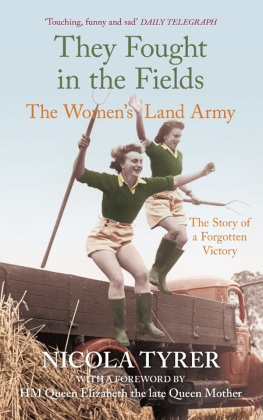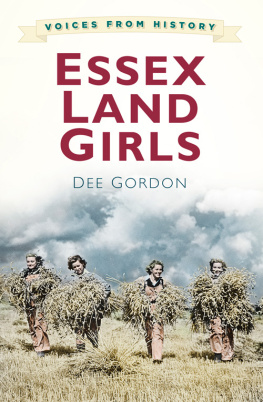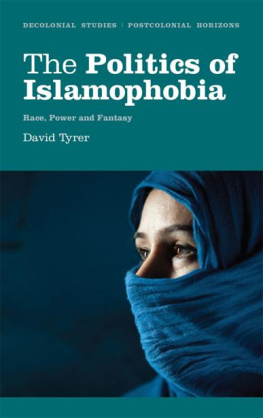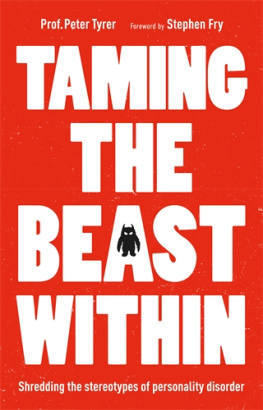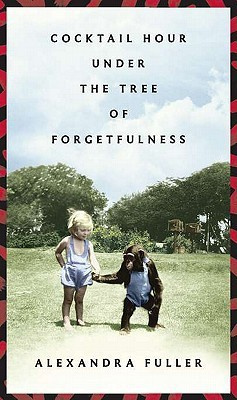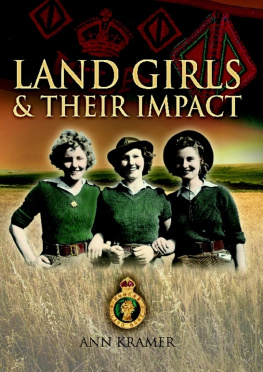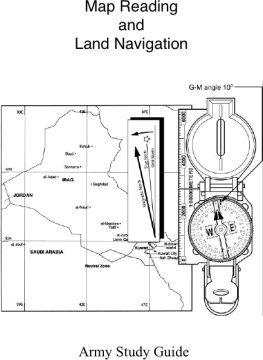Nicola Tyrer - They Fought in the Fields: The Womens Land Army
Here you can read online Nicola Tyrer - They Fought in the Fields: The Womens Land Army full text of the book (entire story) in english for free. Download pdf and epub, get meaning, cover and reviews about this ebook. year: 1996, publisher: The History Press, genre: Non-fiction. Description of the work, (preface) as well as reviews are available. Best literature library LitArk.com created for fans of good reading and offers a wide selection of genres:
Romance novel
Science fiction
Adventure
Detective
Science
History
Home and family
Prose
Art
Politics
Computer
Non-fiction
Religion
Business
Children
Humor
Choose a favorite category and find really read worthwhile books. Enjoy immersion in the world of imagination, feel the emotions of the characters or learn something new for yourself, make an fascinating discovery.
- Book:They Fought in the Fields: The Womens Land Army
- Author:
- Publisher:The History Press
- Genre:
- Year:1996
- Rating:4 / 5
- Favourites:Add to favourites
- Your mark:
- 80
- 1
- 2
- 3
- 4
- 5
They Fought in the Fields: The Womens Land Army: summary, description and annotation
We offer to read an annotation, description, summary or preface (depends on what the author of the book "They Fought in the Fields: The Womens Land Army" wrote himself). If you haven't found the necessary information about the book — write in the comments, we will try to find it.
They Fought in the Fields: The Womens Land Army — read online for free the complete book (whole text) full work
Below is the text of the book, divided by pages. System saving the place of the last page read, allows you to conveniently read the book "They Fought in the Fields: The Womens Land Army" online for free, without having to search again every time where you left off. Put a bookmark, and you can go to the page where you finished reading at any time.
Font size:
Interval:
Bookmark:
They Fought
in the Fields
The Womens Land Army
in the Fields
The Womens Land Army
NICOLA TYRER

Cover illustration courtesy of Getty Images.
First published 1996 by Sinclair-Stevenson
This edition first published in 2007 by Tempus Publishing
Reprinted in 2008 by
The History Press
The Mill, Brimscombe Port,
Stroud, Gloucestershire, GL5 2QG
www.thehistorypress.co.uk
This ebook edition first published in 2016
All rights reserved
Nicola Tyrer 1996, 2007
The right of Nicola Tyrer to be identified as the Author
of this work has been asserted in accordance with the
Copyrights, Designs and Patents Act 1988.
This ebook is copyright material and must not be copied, reproduced, transferred, distributed, leased, licensed or publicly performed or used in any way except as specifically permitted in writing by the publishers, as allowed under the terms and conditions under which it was purchased or as strictly permitted by applicable copyright law. Any unauthorised distribution or use of this text may be a direct infringement of the authors and publishers rights, and those responsible may be liable in law accordingly.
EPUB ISBN 978 07524 7342 0
Typesetting and origination by Tempus Publishing Limited
eBook converted by Geethik Technologies
Three hostel pictures
All illustrations are courtesy of the Rural History Centre.
To list all the people who have helped create this portrait of the land girl and her working environment would be a daunting task. But among those who entrusted me with their diaries, letters, newspaper cuttings, photographs, cartoons and treasured copies both of the stylish Land Girl and the workmanlike WLA county newsletters, there are some I would like to single out. The fact that I came to know so many one-time rat catchers, ditch diggers, tractor drivers and tree fellers is due in large measure to the efficiency of Jean Procter, founder and director of the British Womens Land Army Society. Until she set up the BWLAS in 1964, ex-land girls must indeed have felt members of a forgotten army, overlooked year after year at the nations annual remembrance parades. I would also like to thank Mary Twyman, one of the Kent land girls who worked on fields and farms which, because they lay in the flight path to London of enemy aircraft became known as Bomb Alley. Mary Twyman, who received a bravery medal from the King, was to have written her own book on the Land Army but was sadly defeated by ill health. She passed on to me much of the material she had painstakingly compiled and encouraged me to incorporate it into this book. My thanks also to Penelope Greenwood, granddaughter of Lady Denman, Director of the Land Army, for memories which gave new insight into the private side of this remarkable woman; also to Charles Burrell, her nephew, for generously lending me both the entire bound collection of The Land Girl and Lady Denmans private photograph album which celebrates the land girl in all her varied callings. I would also like to pay special tribute to the interview material provided by Joan Mants splendid book All Muck, No Medals (The Book Guild Ltd, 1994, 15.00) which gives graphic insight into just how tough the conditions land girls faced were.
Special thanks too to Dorothy Brant who, as Regional Officer for the North East, was one of Lady Denmans generals; to Marion Nicholson who took the campaign for post-war gratuities to the very topa meeting with Prime Minister Winston Churchill at the House of Commons; to Margaret Drage, who arrived at Balcombe Place, the Land Army HQ, in 1939 as a seventeen-year-old typist, and to Joan Chapman, who was billeted at Sissinghurst Castle, home of WLA-rep. and subsequent chronicler Vita Sackville-West; also to Peg Francis, Evelyn Elliot, Joan Pountney, Joan Collinson, Beety Green, Dinah Pengilly, Ivy Lemon and Johnnie Luxton.
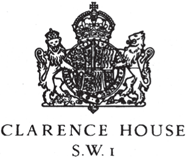
I was indeed proud to be Patron of the Womens Land Army for I remember so well their great contribution to victory in World War II.
No matter the weather, in snow, rain, wind or sun, women all over the country worked tirelessly to fulfil the programme of food production to sustain our Nation. Their unsparing efforts earned our gratitude, and I would like here to pay my own tribute to all those who fought in the fields.
ELIZABETH R
Queen Mother
1996
I decided to write this book firstly because I realised that a generation has grown up who have never heard of the Womens Land Army and secondly because the story of all those inexperienced and idealistic young girls leaving their terraced homes in the cities to take on the task of feeding a nation has always struck me as rather moving. Their efforts may not have changed the lives of women coming after them the way those of the suffragettes didin fact the daughters of land girls usually turn out to be a lot less practical than their mothers. Their sacrifices were not dramatic or life-threatening, as were those of some of the pioneers of womens suffrage. But the success of the WLA, which forced an initially deeply sceptical farming community to eat its words, showed what women can achieve when they are offered a level playing field. For this reason it is part of the womens story.
There is another reason for celebrating the WLA and that is the resolutely cheerful way they coped with what we have come to call the sex war. Most of the women in this book would describe themselves as any mans equal, yet few feel comfortable with the word feminist. To them it has a ring of hostility towards men which they do not recognise. Land girls were undeniably teased and tormented by men who felt threatened by their presence. Instead of crying unfair they got on with the job. Their moment of victory came when, at the announcement that the WLA was being disbanded, the biggest howl of dismay arose from the throat of the once-sceptical National Farmers Union. Girls growing up today are encouraged, quite rightly, to challenge discrimination and demand fairness. Their feminist role models, many of them crop-haired, steel-rimmed pugilists, urge confrontation with the enemy and are out for blood. The land girls made their enemy change sidesand kept their sense of humour. Im sure we can learn from their example.
Dr Johnson, when asked his opinion of women preachers, replied that a woman preaching was like a dog walking on its hind legs: It is not well done, but you are surprized to find it done at all.
Graphic, witty and scornful, the image is Johnson at his misogynistic best. Nearly 200 years later, in 1939, it was with similar scorn that the British farming community greeted the prospect of a Womens Land Army. Their conviction that it couldnt be done is perhaps surprising since only twenty years earlier it had been doneand well done at that.
Most people associate the land girls and their famous uniform of green jerseys and fawn breeches with the Second World War. But mould-breaking though these women were, they had an earlier, even more pioneering precedent. The first Womens Land Army had been set up with tremendous haste in 1917 when, after three years of a harrowing war, starvation loomed. That year Britain was described by its Agriculture Minister as a beleaguered city. Wholesale destruction of food-carrying ships by the ruthlessly efficient German Navy, the run-down state of British farming and the unquenchable demand for men by the Services had reduced the countrys reserve of food to just three weeks. Despite the prevailing view that the land was no place for any decent girl, 43,000 women patriotically applied to join the new force, though half were rejected as unsuited to the toughness of the work. A survey of 12,637 Land Army members in 1918 showed women at work in all fields of agricultural life; there were 5,734 milkers, 293 tractor drivers, 3,971 field workers, 635 carters, 260 plough-men, 84 thatchers and 21 shepherds. What is more, their efforts had proved highly satisfactory and won praise from both farmers and politicians. Memories are short, however, and by the time Britains farmers learnt about plans for a new Land Army on the eve of the Second World War they had conveniently forgotten the unsuspected skills displayed by its older sister.
Next pageFont size:
Interval:
Bookmark:
Similar books «They Fought in the Fields: The Womens Land Army»
Look at similar books to They Fought in the Fields: The Womens Land Army. We have selected literature similar in name and meaning in the hope of providing readers with more options to find new, interesting, not yet read works.
Discussion, reviews of the book They Fought in the Fields: The Womens Land Army and just readers' own opinions. Leave your comments, write what you think about the work, its meaning or the main characters. Specify what exactly you liked and what you didn't like, and why you think so.

